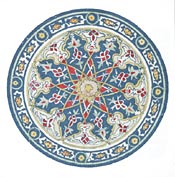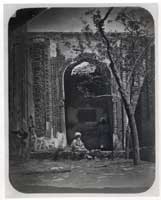Central Asia
|

This Turkestanskii Albom watercolor rendering
of a detail from the mausoleum of Emir Abu-Tengi of Samarkand
testifies to the richness of the monument.
(Prints and
Photographs Division)
|
The lands which stretch from the Eastern Caucasus mountains across
the Caspian Sea and beyond the steppes of Central Asia have long
fascinated the Western world. Encompassing transit points between
East and West--for commerce, migration, and war--and peopled by
a myriad of Turkic and Iranian tribes, as well as other races
and ethnicities, the region is full of wild mountainous vistas
and extensive monotonous plains. Nonetheless, enduring centers
created here have long stirred the imagination. Sheherazade's
thousand and one exotic nights were passed, it should not be forgotten,
in the magical Central Asian city of Samarkand.
The turbulent history of this area together with that of the
various groups populating the Crimea on the northern shores of
the Pontus climaxed inexorably in the Russian conquests of the
nineteenth century and led just as certainly to the eventual status
of these groups as Soviet republics and tributaries. Now, newly
independent after the dissolution of the Soviet Union, the lands
that form Central Asia are the Iranian Tajikastan and the Turkic
Azerbaijan, Kazakhstan, Kyrgyzstan, Tashkent, Turkmenistan, and
Uzbekistan. Although the Crimea and north Caucasus have been retained
as part of Russia--the administrative and ethnic lands of the
Ossetes, the Tatars of the Crimea, and Yakuts, for instance--the
section also preserves their vernacular materials. Linguistically
over twenty-four distinct languages are included in the section's
vernacular materials from the area.
|
 
The images preserved in the extensive Turkestanskii
Albom are both intrinsically sublime and useful to
scholars. [Left] Khimet-Ai, a gracious Uzbek woman
of obvious wealth, poses for the camera's approving lens,
while [Right] the facade of the imposing Mausoleum
of Akmed Hadji in Samarkand displays the importance of public
architecture.
(Prints and
Photographs Division)
|
The General Collections and the Rare Book and Special Collections
Division house many early Western works on the region, from the
familiar travelogue to early histories of Islamic regimes, mercantile
documents, and political discourses. Gradually, nineteenth-century
Russian and European academic publications, such as the highly
regarded French Journal asiatique, began to include studies
of these many and varied peoples. These publications took on greater
urgency in the Soviet period and produced sound critical scholarship.
Particularly impressive was the Zapiski of the Institut
Narodov Azii of the USSR Academy of Sciences.
Serendipity often plays a role in uncovering rare or unique works
from among the millions of items at the Library of Congress. Such
a rarity is the multivolume Turkestanskii Albom,
in the custody of the Prints and Photographs Division. Filled
with ethnographic portraiture, architectural and archaeological
photography, and architectural renderings and watercolors of Russian-held
Central Asia, this priceless resource, which exists in only seven
copies worldwide, was created by Konstantin Petrovich Von Kaufman,
Russian governor-general of Turkestan from 1867 to 1882.
|

The tent-like structures (in Russian, kibitkas)
of the nomads of Turkestan, surrounded by their inhabitants'
household animals, dot the grassy terrain.
(Prints and
Photographs Division)
|
Book printing came to the Turkic and Iranian peoples of Central
Asia only after the Russian conquest of the area. Yet by the beginning
of the twentieth century a number of presses were operating in
Tashkent in two traditions. Following the Russian tradition, some
presses used the post-Kufi Naskh script in
a type font developed during the eighteenth century at the behest
of Catherine II of Russia. Others worked in the Nastaliq
lithograph tradition imported from Iran. A particularly pleasing
example of lithographed Nastaliq works is a copy of
Zakariya Qazwini's Ajaib al-makhluqat
(The wonders of creation) (Tashkent, 1917). In the Russian
Naskh tradition are numerous works held in a separate
collection of Muslim printed materials from the Russian Empire
and Soviet Union dating from before 1946. Of note among these
are a number of children's books printed in Uzbekistan, Turkmenistan,
and the Crimea. Sumptuously illustrated and printed on excellent
paper, they are indicative of a new conception of childhood in
the Muslim societies of the Soviet Union.
|

Vividly colored cavorting chickens and rooster illustrate
Elbek's Hayvanlar, one of the first children's
books published in Tashkent and issued by the Uzbekistan
State Press in 1926. Written by a leading Uzbek author of
that time, it indicates the emphasis placed on children's
literacy during the Soviet period.
(Near
East Section)
|
Although the collection is exceptionally rich in literature,
studies on the history, language, art, and architecture of each
of these republics are also well represented. An extensive collection
of Central Asian publications from before and after independence
includes priceless historical periodicals such as Terjuman
(Bahchesaray, the Crimea, 1906-15) and the seminal satirical Azerbaijani
journal Molla Nasreddin (Tiflis, 1906-17).
Adding to the value of the collection are Tajik, Uzbek, Tatar,
and other encyclopedias, as well as the works of important authors
such as Ali Shir Nevai (1441-1501) and the Uzbek, Abdullah Qahhar
(1907-81). Moreover, the section holds complete or nearly complete
runs of serials published by the Turkic peoples of the Soviet
Union since 1955, and particularly since the dissolution of the
Soviet Union. Included among these are all the journals of the
various writers' unions, such as Sharq Yulduzi (Tashkent)
and Zhulduz (Alma Ata). Post-independence resurgence
of nationalism and religious interests has led to as much publication
as each country's economic and political circumstances allow.
The discovery of valuable resources and the growing alliances
between business interests in the West and the governments of
these new states have produced extensive economic, political,
and cultural documentation of the societies, both in Western and
in the vernacular languages. There is a growing interest in the
burgeoning popular culture as well, as witnessed by the acquisitions
of the popular literary works of Central Asia's contemporary authors.
|
 The influential Azerbaijani-language Molla
Nasreddin, the first satirical journal in the Russian
Empire, was published in Tiflis/Tbilisi, Georgia, the administrative
capital of Transcaucasia from 1905 to 1917, and targeted
the educated Azerbaijani classes. The cover page of the
November 22, 1909, issue compellingly details the internal
fragmentation of Islam in the Russian Caucasus.
The influential Azerbaijani-language Molla
Nasreddin, the first satirical journal in the Russian
Empire, was published in Tiflis/Tbilisi, Georgia, the administrative
capital of Transcaucasia from 1905 to 1917, and targeted
the educated Azerbaijani classes. The cover page of the
November 22, 1909, issue compellingly details the internal
fragmentation of Islam in the Russian Caucasus.
(Near
East Section)
|
What was a compact academic collection has emerged into one capable
of supporting advanced multidisciplinary research. As democracy
takes hold and economic and political alliances with the West
evolve, the Near East Section fully intends to expand its collections
of Central Asian materials proportionately.
|